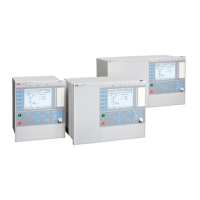• Phase-to-phase current variation
• Zero sequence current criterion
• Low voltage criterion
• Low current criterion
Phase-to-phase current variation takes the current samples as
input and it calculates the variation using the sampling value
based algorithm. Phase-to-phase current variation function is
major one to fulfill the objectives of the startup element.
Zero sequence criterion takes the zero sequence current as
input. It increases the security of protection during the high
impedance fault conditions.
Low voltage criterion takes the phase voltages and phase-to-
phase voltages as inputs. It increases the security of protection
when the three-phase fault occurred on the weak end side.
Low current criterion takes the phase currents as inputs and it
increases the dependability during the switch onto fault case of
unloaded line.
The differential function can be allowed to trip as no load is fed
through the line and protection is not working correctly.
Features:
• Startup element is sensitive enough to detect the
abnormal status of the protected system
• Startup element does not influence the operation speed of
main protection
• Startup element would detect the evolving faults, high
impedance faults and three phase fault on weak side
• It is possible to block the each sub function of startup
element
• Startup signal has a settable pulse time
4. Impedance protection
Distance measuring zone, quadrilateral characteristic
ZMQPDIS, ZMQAPDIS
The line distance protection is an up to five (depending on
product variant) zone full scheme protection function with three
fault loops for phase-to-phase faults and three fault loops for
phase-to-earth faults for each of the independent zones.
Individual settings for each zone in resistive and reactive reach
gives flexibility for use as back-up protection for transformer
connected to overhead lines and cables of different types and
lengths.
ZMQPDIS together with Phase selection with load
encroachment FDPSPDIS has functionality for load
encroachment, which increases the possibility to detect high
resistive faults on heavily loaded lines, as shown in figure
9.
en05000034.vsd
R
X
Forward
operation
Reverse
operation
IEC05000034 V1 EN
Figure 9. Typical quadrilateral distance protection zone with Phase
selection with load encroachment function FDPSPDIS
activated
The independent measurement of impedance for each fault
loop together with a sensitive and reliable built-in phase
selection makes the function suitable in applications with
single-phase autoreclosing.
Built-in adaptive load compensation algorithm prevents
overreaching of zone 1 at load exporting end at phase-to-earth
faults on heavily loaded power lines.
The distance protection zones can operate independently of
each other in directional (forward or reverse) or non-directional
mode. This makes them suitable, together with different
communication schemes, for the protection of power lines and
cables in complex network configurations, such as parallel
lines, multi-terminal lines.
Distance measuring zone, quadrilateral characteristic for
series compensated lines ZMCPDIS, ZMCAPDIS
The line distance protection is a five zone full scheme protection
with three fault loops for phase-to-phase faults and three fault
loops for phase-to-earth fault for each of the independent
zones. Individual settings for each zone resistive and reactive
reach give flexibility for use on overhead lines and cables of
different types and lengths.
Quadrilateral characteristic is available.
ZMCPDIS function has functionality for load encroachment
which increases the possibility to detect high resistive faults on
heavily loaded lines.
Transformer protection RET670 2.0
1MRK 504 141-BEN C
Product version: 2.0
ABB 25

